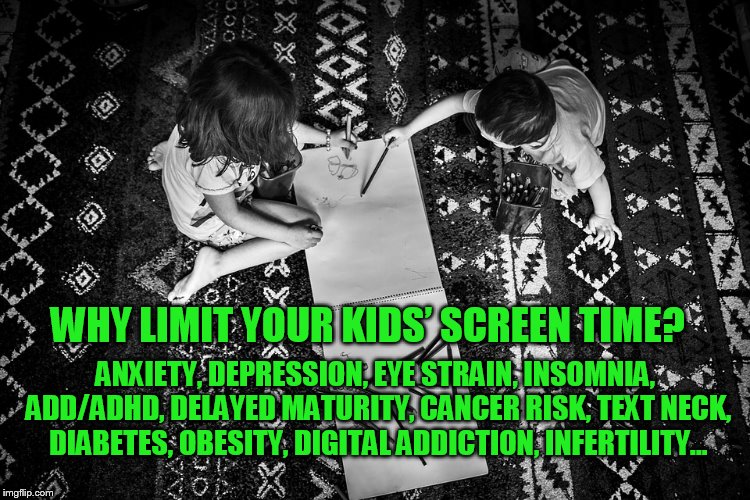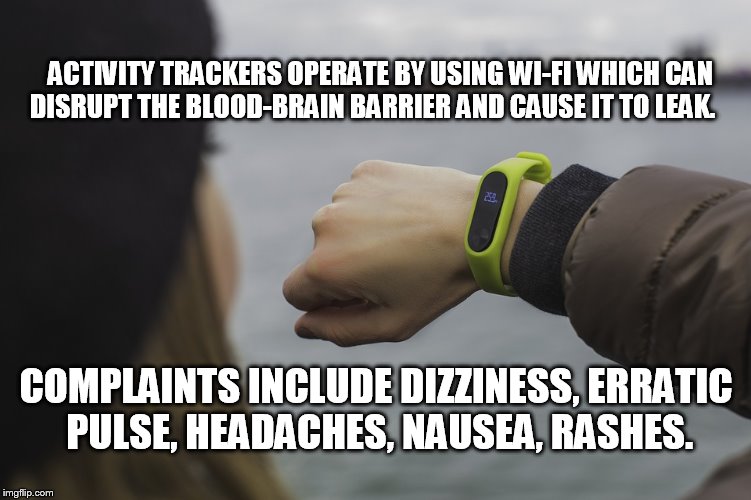 By B.N. Frank
By B.N. Frank
It’s hard to keep track of all the research that has determined kids’ excessive use and exposure to screens is bad for their health. A new study making headlines right now is that screen use and exposure can cause developmental delays in kids under the age of four. A study published in June stated that excessive use of cell phones could shorten kids’ lifespans. One in April concluded it could lead to spinal problems and other risk factors (physical, physiological, psychological, and behavioral). Of course, research has also determined that exposure to blue light from screens (and other sources) is biologically harmful. Additionally, decades of research have also determined that exposure to electromagnetic fields (EMF) from cell phones and other wireless sources – including 5G – is biologically harmful with children being especially vulnerable to it. In fact, manufacturers are required to provide consumers with warnings about radiation exposure from cell phones and other wireless devices.
Weirdly enough, this new study with troubling results was conducted by requiring kids to wear smartwatches to monitor their behavior. Of course, smartwatches (and other wearables) expose wearers to biologically harmful radiation too!
From Study Finds.org:
Inactivity and screen time among children linked to heart damage by young adulthood
KUOPIO, Finland — Allowing children to consistently watch TV for extended periods can lead to heart-related issues years later, a new study warns. Researchers discovered that being inactive from childhood through young adulthood displays a link to heart damage, independent of factors like weight and blood pressure.
For every additional minute of inactivity between ages 11 and 24, there was a 0.004g/m (grams in relation to height) increase in the mass of the heart’s left ventricle by the time these children reached 17 to 24 years of age.
From childhood to young adulthood, sedentary periods increased by an average of 2.8 hours daily, or 169 minutes. At this rate, the left ventricle expanded by 0.7g/m every day. Prior research indicated that a similar growth in the left ventricle mass – specifically 1g/m – over seven years doubled the chances of heart disease, strokes, and death.
The latest study reported that 11-year-old children were inactive for about 362 minutes a day. This rose to 474 minutes by age 15 and 531 minutes by age 24.

Children increase their inactivity to nearly nine hours daily by the time they are teenagers, which can contribute to heart issues. (Photo by Vanessa Loring from Pexels)
“All those hours of screen time in young people add up to a heavier heart, which we know from studies in adults raises the likelihood of heart attack and stroke. Children and teenagers need to move more to protect their long-term health,” says Dr. Andrew Agbaje from the University of Eastern Finland, in a media release. “Children were sedentary for more than six hours a day and this increased by nearly three hours a day by the time they reached young adulthood. Our study indicates that the accumulation of inactive time is related to heart damage regardless of body weight and blood pressure.”
The data for this research came from one of the largest global cohorts, which began tracking children in 1990. It’s the inaugural study delving into the long-term effects of sedentary behavior on the heart.
At ages 11, 15, and 24, the participants wore smartwatches for seven days to monitor their activity levels. During the 15 and 24-year evaluations, researchers used echocardiography, an ultrasound scan, to determine the mass of the heart’s left ventricle.
The study encompassed 766 participants, with 55 percent being girls. The team specifically analyzed the relationship between inactivity from ages 11 to 24 and heart metrics from ages 17 to 24.
“Parents should encourage children and teenagers to move more by taking them out for a walk and limiting time spent on social media and video games. As Martin Luther King Jr. once said, ‘If you can’t fly, run. If you can’t run, walk. If you can’t walk, crawl. But by all means keep moving,’” adds Dr. Agbaje.
The finds were presented at the European Society of Cardiology (ESC) Congress 2023.
You might also be interested in:
- Kids under 6 should keep screen time to a minimum, leading neuropsychologist says
- The simple way to reverse negative impacts of screen time on young kids
- Idle living: 1 in 4 adults admit they lead a sedentary lifestyle
South West News Service writer Pol Allingham contributed to this report.
For several years already, tech experts (aka “Silicon Valley Parents”) have taken great pains to limit their own kids’ use and exposure to screens. This includes sending their kids to low-tech and/or no-tech schools, making their nannies sign “no screens” contracts, and spying on their nannies to make sure they didn’t break their contracts (see 1, 2, 3, 4). Think they were onto something?
Activist Post reports regularly about unsafe technologies. For more information, visit our archives and the following websites:
- Environmental Health Trust
- Children’s Health Defense
- Electromagnetic Radiation Safety
- Physicians for Safe Technology
Become a Patron!
Or support us at SubscribeStar
Donate cryptocurrency HERE
Subscribe to Activist Post for truth, peace, and freedom news. Follow us on SoMee, Telegram, HIVE, Flote, Minds, MeWe, Twitter, Gab, and What Really Happened.
Provide, Protect and Profit from what s coming! Get a free issue of Counter Markets today.


Be the first to comment on "Kids Wore Smartwatches for Study that Revealed They’re More Prone to Heart Issues as Adults from Excessive Screen Time, Inactivity"